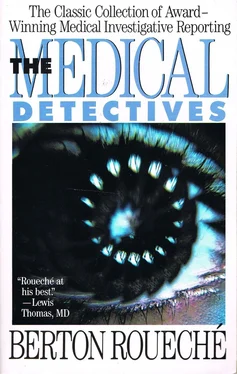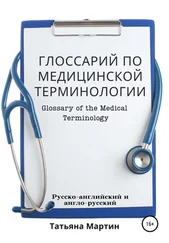Sauer was worse in the morning. The pain had spread to his chest, and when he stood up, he felt dazed and dizzy. He did not, however, return to Lenox Hill. Instead, with the inconstancy of the ailing, he made his way to Metropolitan Hospital, on Welfare Island. He arrived there, shortly before noon, in such a state of confusion and collapse that a nurse had to assist him into the examining room. Half an hour later, having submitted to another potion of bismuth and what turned out to be an uninstructive blood count, he was admitted to a general ward for observation. During the afternoon, his temperature, which earlier had been, equivocally, normal, began to rise. When the resident physician reached him on his evening round, it was a trifle over a hundred and three. As is customary in all but the most crystalline cases, the doctor avoided a flat-footed diagnosis. In his record of the case, he suggested three compatible possibilities. One was aortitis, a heart condition caused by an inflammation of the great trunk artery. The others, both of which were inspired by an admission of intemperance that had been wrung from Sauer in the examining room, were cirrhosis of the liver and gastritis due to alcoholism. At the moment, the doctor indicated, the last appeared to be the most likely.
Gastritis, aortitis, and cirrhosis of the liver, like innumerable other ailments, can seldom be repulsed by specific medication, but time is frequently effective. Sauer responded to neither. His fever held and his symptoms multiplied. He itched all over, an edema sealed his eyes, his voice faded and failed, and the seething pains in his chest and abdomen advanced to his arms and legs. Toward the end of the week, he sank into a stony, comalike apathy. Confronted by this disturbing decline, the house physician reopened his mind and reconsidered the evidence. His adaptability was soon rewarded. He concluded that he was up against an acute and, to judge from his patient's progressive dilapidation, a peculiarly rapacious infection. It was an insinuating notion, but it had one awkward flaw. The white-blood-cell count is a reliable barometer of infection, and Sauer's count had been entirely normal. On Wednesday, April 15, the doctor requested that another count be made. He did not question the accuracy of the original test, but the thought had occurred to him that it might have been made prematurely. The report from the laboratory was on his desk when he reached the hospital the following day. It more than confirmed his hunch. It also relieved him simultaneously of both uncertainty and hope. Sauer's white count was morbidly elevated by a preponderance of eosinophiles, a variety of cell that is produced by several potentially epidemic diseases but just one as formidably dishevelling as the case in question. The doctor put down the report and called the hospital superintendent's office. He asked the clerk who answered the phone to inform the Department of Health, to which the appearance of any disease of an epidemiological nature must be promptly communicated, that he had just uncovered a case of trichinosis.
The cause of trichinosis is a voracious endoparasitic worm, Tri-chinella spiralis , commonly called trichina, that lodges in the muscle fibers of an animal host. It enters the host by way of the alimentary canal, and in the intestine produces larvae that penetrate the intestinal walls to enter the blood stream. The worm is staggeringly prolific, and it has been known to remain alive, though quiescent, in the body of a surviving victim for thirty-one years. In general, the number of trichinae that succeed in reaching the muscle determines the severity of an attack. As such parasitic organisms go, adult trichinae are relatively large, the males averaging one-twentieth of an inch in length and the females about twice that. The larvae are less statuesque. Pathologists have found as many as twelve hundred of them encysted in a single gram of tissue. Numerous animals, ranging in size from the mole to the hippopotamus, are hospitable to the trichina, but it has a strong predilection for swine and man. Man's only important source of infection is pork. The disease is perpetuated in swine by the practice common among hog raisers of using garbage, some of which inevitably contains trichinous meat, for feed. Swine have a high degree of tolerance for the trichina, but man's resistive powers are feeble. In 1931, in Detroit, a man suffered a violent seizure of trichinosis as a result of merely eating a piece of bread buttered with a knife that had been used to slice an infested sausage. The hog from which the sausage was made had appeared to be in excellent health. Few acute afflictions are more painful than trichinosis, or more prolonged and debilitating. Its victims are occasionally prostrated for many months, and relapses after apparent recoveries are not uncommon. Its mortality rate is disconcertingly variable. It is usually around six percent, but in some outbreaks nearly a third of those stricken have died, and the recovery of a patient from a full-scale attack is almost unheard of. Nobody is, or can be rendered, immune to trichinosis. Also, there is no specific cure. In the opinion of most investigators, it is far from likely that one will ever be found. They are persuaded that any therapeutic agent potent enough to kill a multitude of embedded trichinae would probably kill the patient, too.
Although medical science is unable to terminate, or even lessen the severity of, an assault of trichinosis, no disease is easier to dodge. There are several dependable means of evasion. Abstention from pork is, of course, one. It is also the most venerable, having been known, vigorously recommended, and widely practiced for at least three thousand years. Some authorities, in fact, regard the Mosaic proscription of pork as the pioneering step in the development of preventive medicine. However, since the middle of the nineteenth century, when the cause and nature of trichinosis were illuminated by Sir James Paget, Rudolf Virchow, Friedrich Albert von Zenker, and others, less ascetic safeguards have become available. The trichinae are rugged but not indestructible. It has been amply demonstrated that thorough cooking (until the meat is bone-white) will make even the wormiest pork harmless. So will refrigeration at a maximum temperature of five degrees for a minimum of twenty days. So, just as effectively, will certain scrupulous methods of salting, smoking, and pickling.
Despite this abundance of easily applied defensive techniques, the incidence of trichinosis has not greatly diminished over the globe in the past fifty or sixty years. In some countries, it has even increased. The United States is one of them. Many epidemiologists are convinced that this country now leads the world in trichinosis.
It is, at any rate, a major health problem here. According to a compendium of recent autopsy studies, approximately one American in five has at some time or another had trichinosis, and it is probable that well over a million are afflicted with it every year. As a considerable source of misery, it ranks with tuberculosis, syphilis, and undulant fever. It will probably continue to be one for some time to come. Its spread is almost unimpeded. A few states, New York among them, have statutes prohibiting the feeding of uncooked garbage to swine, but nowhere is a very determined effort made at enforcement, and the Bureau of Animal Industry of the United States Department of Agriculture, although it assumes all pork to be trichinous until proved otherwise, requires packing houses to administer a prophylactic freeze to only those varieties of the meat—frankfurters, salami, prosciutto, and the like—that are often eaten raw. Moreover, not all processed pork comes under the jurisdiction of the Department. At least a third of it is processed under local ordinances in small, neighborhood abattoirs beyond the reach of the Bureau, or on farms. Nearly two per cent of the hogs slaughtered in the United States are trichinous.
Читать дальше












